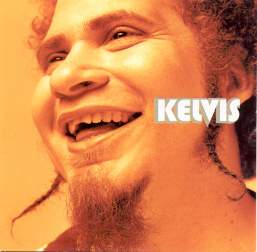12.16.1 Kelvis Ochoa

Kelvis Ochoa is a prominent Cuban singer-songwriter; he was born in 1970 in the province of Las Tunas. He moved to the Isle of Youth with his grandparents at a very young age, until 1992, when he settled in Havana. Coming from a family of musicians, he lived in a musical environment from childhood.
At just nine years old, he sang in a children’s duet with his sister. At ten, he began his training in the choir of the Cultural Center of Girona (the capital of the Isle of Youth). He joined the Hermanos Saiz Association at 18, in a cultural project on the Isle of Youth called Los Diablitos.
In 1992, in Havana, he came into contact with the cultural circles of the time, training with the new generation of composers, artists, and performers who emerged with their own identity during that period.
In Cuba, he joined several groups, but it was with Cuatro Gatos (1994) that he participated in the album Habana Oculta, produced by Gema and Pavel. To promote this album, Kelvis traveled to Spain in July 1996 with other artists from the project. He performed at the Bilbao Tropical Festival and in several concerts in venues.
After the albums Habana Oculta (released in Havana) and Habana Abierta (released in Madrid), she released the album “24 horas,” which includes, among others, the song “Cuando salí de la Habana” (When I Left Havana) (1999), probably Habana Abierta’s first hit in Spain. “Si tu no quieres” (If You Don’t Want) is the second single from this album. A fresh track, in which the unruly instrumental base, along with the bass and horns, reveal the best example of the fusion that Kelvis Ochoa projects in his work. Added to this, in a rap key, is the sensual voice of Brazilian Fernanda Abreu and production by Alejo Stivel. Their second album was recorded at PM Records studios (Calle 11 No. 257 between J and I, Vedado, Havana), in Havana.
In 2007, her album Amor y Música was released, alongside Descemer Bueno, under the EGREM label. The album features a collaboration between Kelvis and Descemer, with the majority of the tracks, and features musicians such as Carlos Varela, Roberto Carcassés, and Polito Ibañez.
On October 9, 2009, Kelvis participated in the concert that the French artist Manu Chao performed as a tribute to Commander Ernesto Che Guevara, on the steps of the University of Havana (University Avenue and G. Vedado. Plaza de la Revolución. Havana).
In February 2010, Descemer Bueno and Kelvis Ochoa joined forces for Haiti at a humanitarian concert held in the Dominican Republic. That same year, the Cuban singer also performed as one of the guests at the Puerto Rican duo Calle 13’s unique concert in Havana.
The popular author and performer, along with his guests, also closed the artistic and cultural event “With Fidel and for Peace” in August 2010, on the steps of the University of Havana (University Avenue and Vedado, Plaza de la Revolución, Havana). The concert was attended by thousands of young people. He also opened the musical segment of the 20th International Book Fair, Cuba 2011, at the Cuban Pavilion (23rd Street, corner of N, Vedado, Plaza de la Revolución, Havana).
Throughout his artistic career, Kelvis Ochoa has worked with musicians such as Lolita, Pastora Soler, Pavel Urquiza, Descemer Bueno, Roberto Carcassés, Edesio Alejandro, Haydee Milanés, Yusa, Athanay, Francis del Río, Samuel Formell, Elmer Ferrer, Nan Sam Fong, Ojos de Brujo, Manu Chau, the Puerto Rican group Calle 13, among others.
He has composed works for Raimundo Amador, Tomasito, and Beatriz Márquez. He has composed music for the film soundtracks: “Vampires in Havana” (Juan Padrón, Cuba); “Barrio Cuba” (Humberto Solás, Cuba, 2005); “Heart of Time/Heart of Time” (Alberto Cortés, Mexico); “Lisanka” (Daniel Díaz Torres, 2009). He has also collaborated on albums by Tino Di Geraldo.
Kelvis Ochoa was awarded the 2006 Goya Award for Best Original Music as co-writer of the soundtrack for the film “Havana Blues.” He is a master at combining traditional rhythms such as Son, Cha-Cha-Cha, Sucu-Sucu, Songo, Conga, and Timba, among others, with influences from Funky, Chili-Pepper Rock and Pop, Antillean and international Pop. He is a prototype of the most innovative Cuban music.








